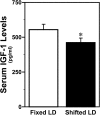Sex Differences in the Impact of Shift Work Schedules on Pathological Outcomes in an Animal Model of Ischemic Stroke
- PMID: 27254002
- PMCID: PMC4929545
- DOI: 10.1210/en.2016-1130
Sex Differences in the Impact of Shift Work Schedules on Pathological Outcomes in an Animal Model of Ischemic Stroke
Abstract
Circadian clock desynchronization has been implicated in the pathophysiology of cardiovascular disease and related risk factors (eg, obesity, diabetes). Thus, we examined the extent to which circadian desynchronization exacerbates ischemic stroke outcomes and whether its detrimental effects on stroke severity and functional impairments are further modified by biological sex. Circadian entrainment of activity rhythms in all male and female rats was observed during exposure to a fixed light-dark (LD) 12:12 cycle but was severely disrupted when this LD cycle was routinely shifted (12 h advance/5 d) for approximately 7 weeks. In contrast to the regular estrous cycles in fixed LD animals, cyclicity was abolished and persistent estrus was evident in all shifted LD females. The disruption of estrous cyclicity in shifted LD females was associated with a significant increase in serum estradiol levels relative to that observed in fixed LD controls. Circadian rhythm disruption exacerbated stroke outcomes in both shifted LD male and female rats and further amplified sex differences in stroke impairments. In males, but not females, circadian disruption after exposure to the shifted LD cycle was marked by high rates of mortality. In surviving females, circadian desynchronization after exposure to shifted LD cycles produced significant increases in stroke-induced infarct volume and sensorimotor deficits with corresponding decreases in serum IGF-1 levels. These results suggest that circadian rhythm disruption associated with shift work schedules or the irregular nature of our everyday work and/or social environments may interact with other nonmodifiable risk factors such as biological sex to modulate the pathological effects of stroke.
Figures







Similar articles
-
Sex differences in the diathetic effects of shift work schedules on circulating cytokine levels and pathological outcomes of ischemic stroke during middle age.Neurobiol Sleep Circadian Rhythms. 2022 Jun 23;13:100079. doi: 10.1016/j.nbscr.2022.100079. eCollection 2022 Nov. Neurobiol Sleep Circadian Rhythms. 2022. PMID: 35800977 Free PMC article.
-
Shift work schedules alter immune cell regulation and accelerate cognitive impairment during aging.J Neuroinflammation. 2025 Jan 8;22(1):4. doi: 10.1186/s12974-024-03324-z. J Neuroinflammation. 2025. PMID: 39780172 Free PMC article.
-
Social interaction and sex differences influence rat temperature circadian rhythm under LD cycles and constant light.Physiol Behav. 2011 Jun 1;103(3-4):365-71. doi: 10.1016/j.physbeh.2011.03.010. Epub 2011 Mar 17. Physiol Behav. 2011. PMID: 21402091
-
Quantifying light-dependent circadian disruption in humans and animal models.Chronobiol Int. 2014 Dec;31(10):1239-46. doi: 10.3109/07420528.2014.957302. Epub 2014 Sep 17. Chronobiol Int. 2014. PMID: 25229212 Free PMC article. Review.
-
Time to Target Stroke: Examining the Circadian System in Stroke.Yale J Biol Med. 2019 Jun 27;92(2):349-357. eCollection 2019 Jun. Yale J Biol Med. 2019. PMID: 31249495 Free PMC article. Review.
Cited by
-
Cerebrovascular Disease in the Young Adult: Examining Melatonin's Possible Multiple Roles.J Exp Neurosci. 2019 Feb 5;13:1179069519827300. doi: 10.1177/1179069519827300. eCollection 2019. J Exp Neurosci. 2019. PMID: 30783379 Free PMC article. Review.
-
Disruptions of Circadian Rhythms and Thrombolytic Therapy During Ischemic Stroke Intervention.Front Neurosci. 2021 Jun 10;15:675732. doi: 10.3389/fnins.2021.675732. eCollection 2021. Front Neurosci. 2021. PMID: 34177452 Free PMC article. Review.
-
Role of circadian rhythms in pathogenesis of acute CNS injuries: Insights from experimental studies.Exp Neurol. 2022 Jul;353:114080. doi: 10.1016/j.expneurol.2022.114080. Epub 2022 Apr 9. Exp Neurol. 2022. PMID: 35405120 Free PMC article. Review.
-
Circadian rhythm, glucose metabolism and diabetic complications: the role of glucokinase and the enlightenment on future treatment.Front Physiol. 2025 Feb 21;16:1537231. doi: 10.3389/fphys.2025.1537231. eCollection 2025. Front Physiol. 2025. PMID: 40061454 Free PMC article. Review.
-
The intersection of circadian rhythms and the blood-brain barrier with drug efficacy and delivery in neurological disorders.Adv Drug Deliv Rev. 2025 Sep;224:115645. doi: 10.1016/j.addr.2025.115645. Epub 2025 Jul 2. Adv Drug Deliv Rev. 2025. PMID: 40614866 Review.
References
-
- Penev PD, Kolker DE, Zee PC, Turek FW. Chronic circadian desynchronization decreases the survival of animals with cardiomyopathic heart disease. Am J Physiol. 1998;275:H2334–H2337. - PubMed
Publication types
MeSH terms
Grants and funding
LinkOut - more resources
Full Text Sources
Other Literature Sources
Medical
Research Materials
Miscellaneous

